Scientific Management & Human Relations: Modern Management Impact
VerifiedAdded on 2021/06/17
|9
|2082
|67
Essay
AI Summary
This essay critically compares and contrasts the contributions of scientific management, pioneered by Frederick Winslow Taylor, and the human relations movement, exemplified by Elton Mayo's Hawthorne studies, to modern management theory and practice. The essay begins by outlining the core principles of scientific management, including the optimization of work processes, scientific selection and training of employees, and the importance of cooperation between management and workers. It then explores the human relations movement, highlighting its focus on employee social needs, informal work environments, and the significance of employee involvement in decision-making. The essay further discusses the key differences between the two theories, such as Taylor's emphasis on economic incentives versus Mayo's focus on social and psychological factors. It also analyzes the similarities, such as the shared goal of enhancing productivity and motivating employees. Finally, the essay evaluates the relevance of both theories in the contemporary business environment, concluding that both scientific management and human relations have significantly shaped modern management practices, with organizations often adopting a blend of both approaches to maximize efficiency and foster a positive work environment. The essay references relevant academic literature to support its arguments and provides a comprehensive overview of the evolution of management thought.
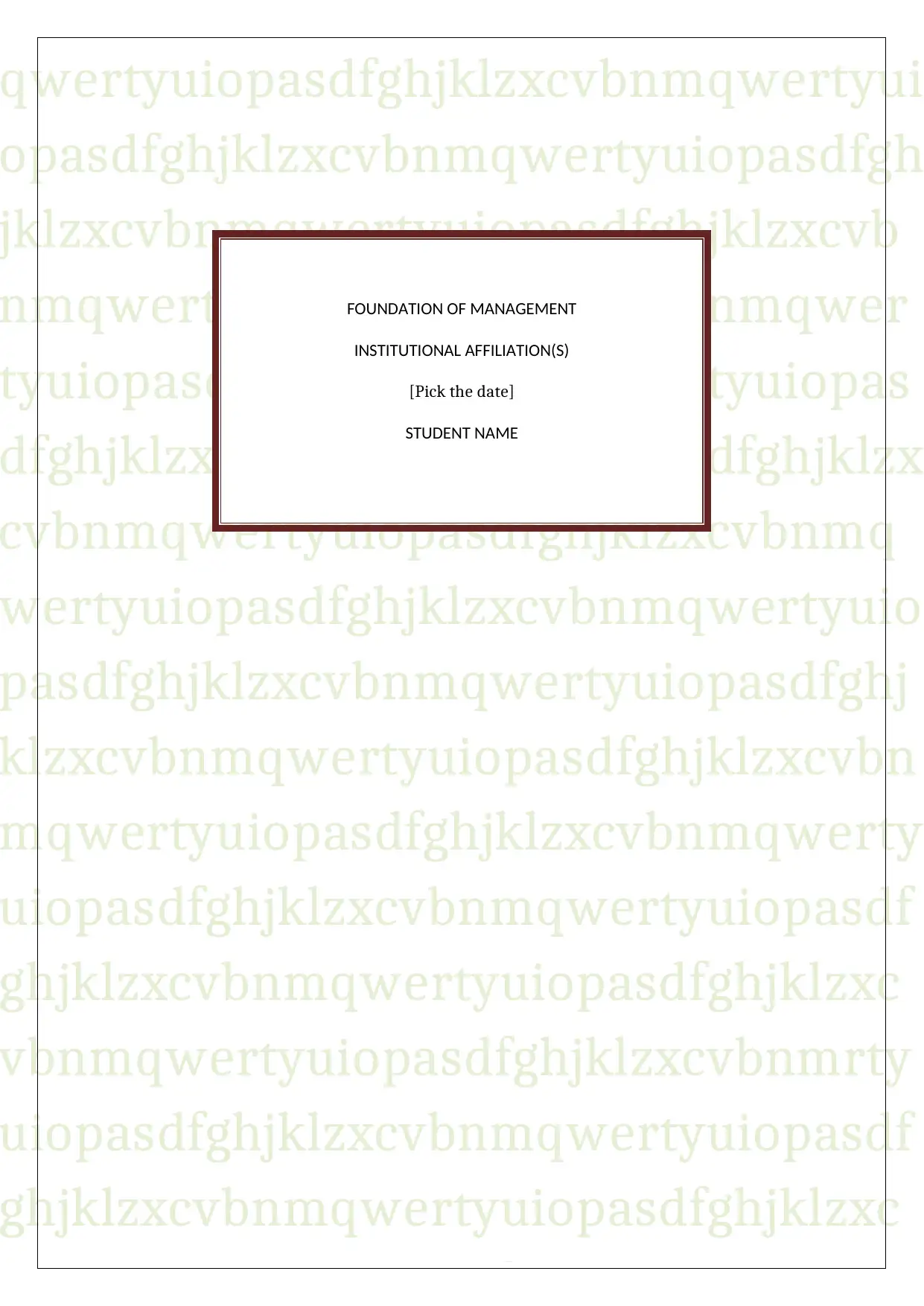
qwertyuiopasdfghjklzxcvbnmqwertyui
opasdfghjklzxcvbnmqwertyuiopasdfgh
jklzxcvbnmqwertyuiopasdfghjklzxcvb
nmqwertyuiopasdfghjklzxcvbnmqwer
tyuiopasdfghjklzxcvbnmqwertyuiopas
dfghjklzxcvbnmqwertyuiopasdfghjklzx
cvbnmqwertyuiopasdfghjklzxcvbnmq
wertyuiopasdfghjklzxcvbnmqwertyuio
pasdfghjklzxcvbnmqwertyuiopasdfghj
klzxcvbnmqwertyuiopasdfghjklzxcvbn
mqwertyuiopasdfghjklzxcvbnmqwerty
uiopasdfghjklzxcvbnmqwertyuiopasdf
ghjklzxcvbnmqwertyuiopasdfghjklzxc
vbnmqwertyuiopasdfghjklzxcvbnmrty
uiopasdfghjklzxcvbnmqwertyuiopasdf
ghjklzxcvbnmqwertyuiopasdfghjklzxc
vbnmqwertyuiopasdfghjklzxcvbnmqw
FOUNDATION OF MANAGEMENT
INSTITUTIONAL AFFILIATION(S)
[Pick the date]
STUDENT NAME
opasdfghjklzxcvbnmqwertyuiopasdfgh
jklzxcvbnmqwertyuiopasdfghjklzxcvb
nmqwertyuiopasdfghjklzxcvbnmqwer
tyuiopasdfghjklzxcvbnmqwertyuiopas
dfghjklzxcvbnmqwertyuiopasdfghjklzx
cvbnmqwertyuiopasdfghjklzxcvbnmq
wertyuiopasdfghjklzxcvbnmqwertyuio
pasdfghjklzxcvbnmqwertyuiopasdfghj
klzxcvbnmqwertyuiopasdfghjklzxcvbn
mqwertyuiopasdfghjklzxcvbnmqwerty
uiopasdfghjklzxcvbnmqwertyuiopasdf
ghjklzxcvbnmqwertyuiopasdfghjklzxc
vbnmqwertyuiopasdfghjklzxcvbnmrty
uiopasdfghjklzxcvbnmqwertyuiopasdf
ghjklzxcvbnmqwertyuiopasdfghjklzxc
vbnmqwertyuiopasdfghjklzxcvbnmqw
FOUNDATION OF MANAGEMENT
INSTITUTIONAL AFFILIATION(S)
[Pick the date]
STUDENT NAME
Paraphrase This Document
Need a fresh take? Get an instant paraphrase of this document with our AI Paraphraser
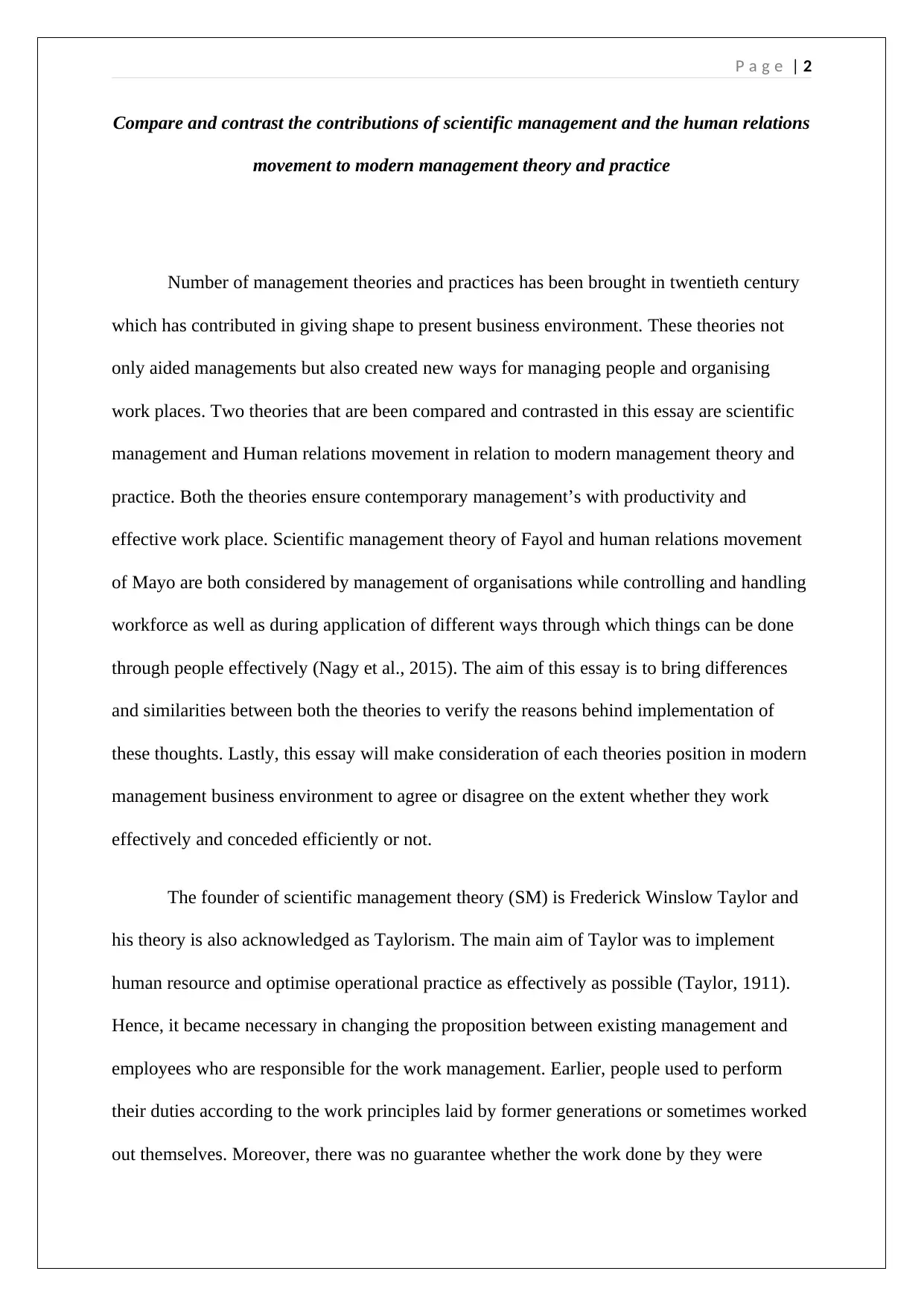
P a g e | 2
Compare and contrast the contributions of scientific management and the human relations
movement to modern management theory and practice
Number of management theories and practices has been brought in twentieth century
which has contributed in giving shape to present business environment. These theories not
only aided managements but also created new ways for managing people and organising
work places. Two theories that are been compared and contrasted in this essay are scientific
management and Human relations movement in relation to modern management theory and
practice. Both the theories ensure contemporary management’s with productivity and
effective work place. Scientific management theory of Fayol and human relations movement
of Mayo are both considered by management of organisations while controlling and handling
workforce as well as during application of different ways through which things can be done
through people effectively (Nagy et al., 2015). The aim of this essay is to bring differences
and similarities between both the theories to verify the reasons behind implementation of
these thoughts. Lastly, this essay will make consideration of each theories position in modern
management business environment to agree or disagree on the extent whether they work
effectively and conceded efficiently or not.
The founder of scientific management theory (SM) is Frederick Winslow Taylor and
his theory is also acknowledged as Taylorism. The main aim of Taylor was to implement
human resource and optimise operational practice as effectively as possible (Taylor, 1911).
Hence, it became necessary in changing the proposition between existing management and
employees who are responsible for the work management. Earlier, people used to perform
their duties according to the work principles laid by former generations or sometimes worked
out themselves. Moreover, there was no guarantee whether the work done by they were
Compare and contrast the contributions of scientific management and the human relations
movement to modern management theory and practice
Number of management theories and practices has been brought in twentieth century
which has contributed in giving shape to present business environment. These theories not
only aided managements but also created new ways for managing people and organising
work places. Two theories that are been compared and contrasted in this essay are scientific
management and Human relations movement in relation to modern management theory and
practice. Both the theories ensure contemporary management’s with productivity and
effective work place. Scientific management theory of Fayol and human relations movement
of Mayo are both considered by management of organisations while controlling and handling
workforce as well as during application of different ways through which things can be done
through people effectively (Nagy et al., 2015). The aim of this essay is to bring differences
and similarities between both the theories to verify the reasons behind implementation of
these thoughts. Lastly, this essay will make consideration of each theories position in modern
management business environment to agree or disagree on the extent whether they work
effectively and conceded efficiently or not.
The founder of scientific management theory (SM) is Frederick Winslow Taylor and
his theory is also acknowledged as Taylorism. The main aim of Taylor was to implement
human resource and optimise operational practice as effectively as possible (Taylor, 1911).
Hence, it became necessary in changing the proposition between existing management and
employees who are responsible for the work management. Earlier, people used to perform
their duties according to the work principles laid by former generations or sometimes worked
out themselves. Moreover, there was no guarantee whether the work done by they were
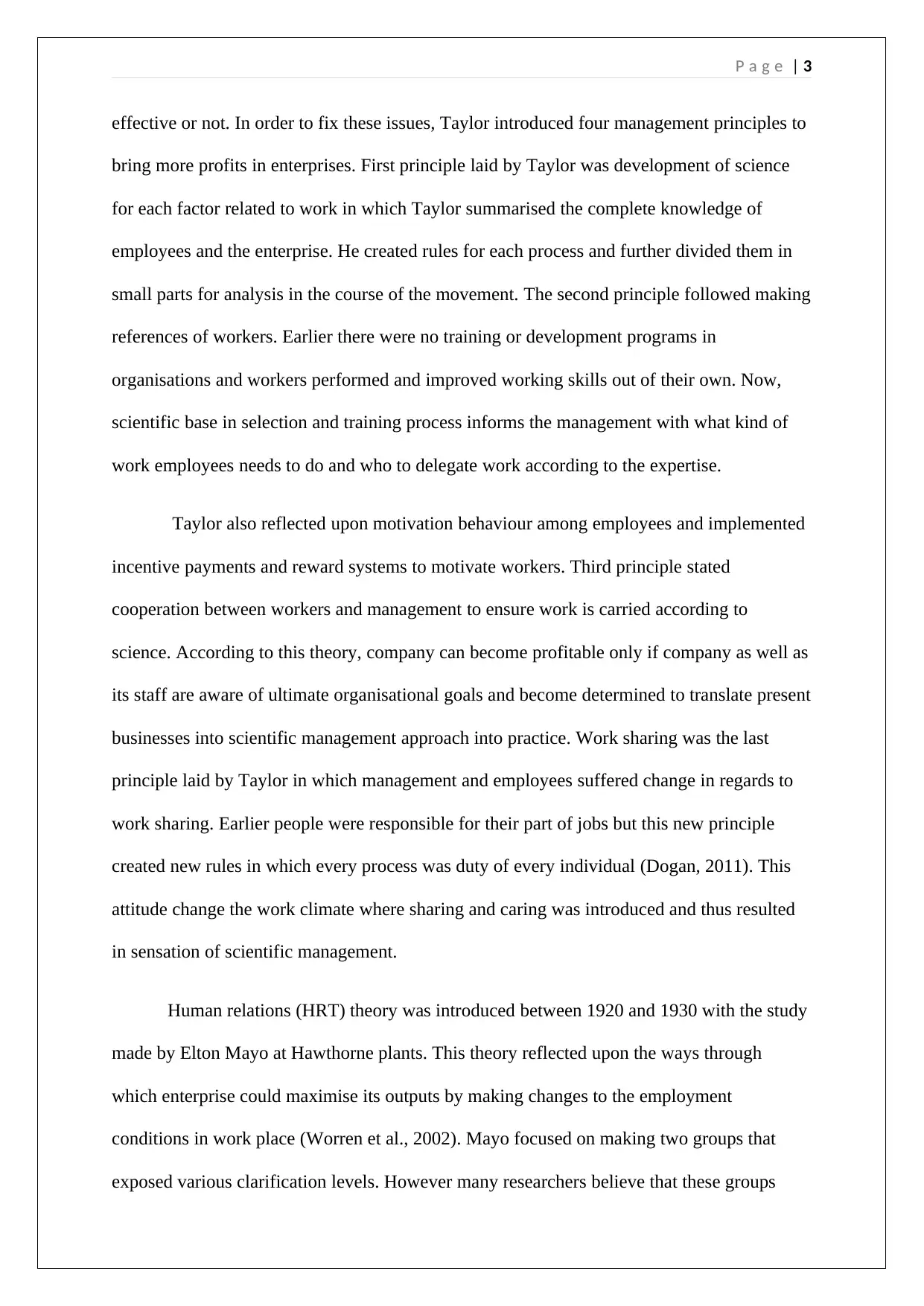
P a g e | 3
effective or not. In order to fix these issues, Taylor introduced four management principles to
bring more profits in enterprises. First principle laid by Taylor was development of science
for each factor related to work in which Taylor summarised the complete knowledge of
employees and the enterprise. He created rules for each process and further divided them in
small parts for analysis in the course of the movement. The second principle followed making
references of workers. Earlier there were no training or development programs in
organisations and workers performed and improved working skills out of their own. Now,
scientific base in selection and training process informs the management with what kind of
work employees needs to do and who to delegate work according to the expertise.
Taylor also reflected upon motivation behaviour among employees and implemented
incentive payments and reward systems to motivate workers. Third principle stated
cooperation between workers and management to ensure work is carried according to
science. According to this theory, company can become profitable only if company as well as
its staff are aware of ultimate organisational goals and become determined to translate present
businesses into scientific management approach into practice. Work sharing was the last
principle laid by Taylor in which management and employees suffered change in regards to
work sharing. Earlier people were responsible for their part of jobs but this new principle
created new rules in which every process was duty of every individual (Dogan, 2011). This
attitude change the work climate where sharing and caring was introduced and thus resulted
in sensation of scientific management.
Human relations (HRT) theory was introduced between 1920 and 1930 with the study
made by Elton Mayo at Hawthorne plants. This theory reflected upon the ways through
which enterprise could maximise its outputs by making changes to the employment
conditions in work place (Worren et al., 2002). Mayo focused on making two groups that
exposed various clarification levels. However many researchers believe that these groups
effective or not. In order to fix these issues, Taylor introduced four management principles to
bring more profits in enterprises. First principle laid by Taylor was development of science
for each factor related to work in which Taylor summarised the complete knowledge of
employees and the enterprise. He created rules for each process and further divided them in
small parts for analysis in the course of the movement. The second principle followed making
references of workers. Earlier there were no training or development programs in
organisations and workers performed and improved working skills out of their own. Now,
scientific base in selection and training process informs the management with what kind of
work employees needs to do and who to delegate work according to the expertise.
Taylor also reflected upon motivation behaviour among employees and implemented
incentive payments and reward systems to motivate workers. Third principle stated
cooperation between workers and management to ensure work is carried according to
science. According to this theory, company can become profitable only if company as well as
its staff are aware of ultimate organisational goals and become determined to translate present
businesses into scientific management approach into practice. Work sharing was the last
principle laid by Taylor in which management and employees suffered change in regards to
work sharing. Earlier people were responsible for their part of jobs but this new principle
created new rules in which every process was duty of every individual (Dogan, 2011). This
attitude change the work climate where sharing and caring was introduced and thus resulted
in sensation of scientific management.
Human relations (HRT) theory was introduced between 1920 and 1930 with the study
made by Elton Mayo at Hawthorne plants. This theory reflected upon the ways through
which enterprise could maximise its outputs by making changes to the employment
conditions in work place (Worren et al., 2002). Mayo focused on making two groups that
exposed various clarification levels. However many researchers believe that these groups
⊘ This is a preview!⊘
Do you want full access?
Subscribe today to unlock all pages.

Trusted by 1+ million students worldwide
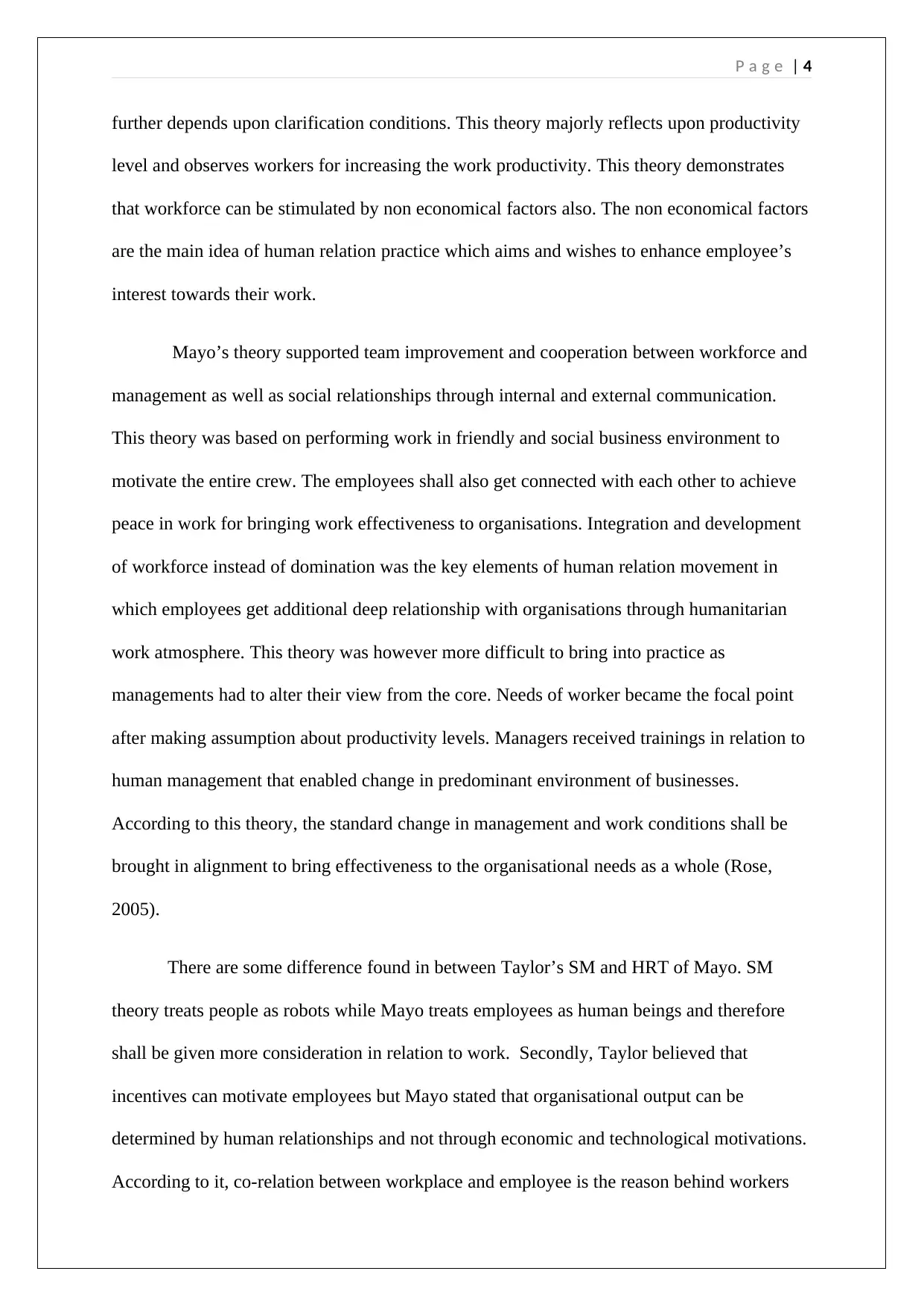
P a g e | 4
further depends upon clarification conditions. This theory majorly reflects upon productivity
level and observes workers for increasing the work productivity. This theory demonstrates
that workforce can be stimulated by non economical factors also. The non economical factors
are the main idea of human relation practice which aims and wishes to enhance employee’s
interest towards their work.
Mayo’s theory supported team improvement and cooperation between workforce and
management as well as social relationships through internal and external communication.
This theory was based on performing work in friendly and social business environment to
motivate the entire crew. The employees shall also get connected with each other to achieve
peace in work for bringing work effectiveness to organisations. Integration and development
of workforce instead of domination was the key elements of human relation movement in
which employees get additional deep relationship with organisations through humanitarian
work atmosphere. This theory was however more difficult to bring into practice as
managements had to alter their view from the core. Needs of worker became the focal point
after making assumption about productivity levels. Managers received trainings in relation to
human management that enabled change in predominant environment of businesses.
According to this theory, the standard change in management and work conditions shall be
brought in alignment to bring effectiveness to the organisational needs as a whole (Rose,
2005).
There are some difference found in between Taylor’s SM and HRT of Mayo. SM
theory treats people as robots while Mayo treats employees as human beings and therefore
shall be given more consideration in relation to work. Secondly, Taylor believed that
incentives can motivate employees but Mayo stated that organisational output can be
determined by human relationships and not through economic and technological motivations.
According to it, co-relation between workplace and employee is the reason behind workers
further depends upon clarification conditions. This theory majorly reflects upon productivity
level and observes workers for increasing the work productivity. This theory demonstrates
that workforce can be stimulated by non economical factors also. The non economical factors
are the main idea of human relation practice which aims and wishes to enhance employee’s
interest towards their work.
Mayo’s theory supported team improvement and cooperation between workforce and
management as well as social relationships through internal and external communication.
This theory was based on performing work in friendly and social business environment to
motivate the entire crew. The employees shall also get connected with each other to achieve
peace in work for bringing work effectiveness to organisations. Integration and development
of workforce instead of domination was the key elements of human relation movement in
which employees get additional deep relationship with organisations through humanitarian
work atmosphere. This theory was however more difficult to bring into practice as
managements had to alter their view from the core. Needs of worker became the focal point
after making assumption about productivity levels. Managers received trainings in relation to
human management that enabled change in predominant environment of businesses.
According to this theory, the standard change in management and work conditions shall be
brought in alignment to bring effectiveness to the organisational needs as a whole (Rose,
2005).
There are some difference found in between Taylor’s SM and HRT of Mayo. SM
theory treats people as robots while Mayo treats employees as human beings and therefore
shall be given more consideration in relation to work. Secondly, Taylor believed that
incentives can motivate employees but Mayo stated that organisational output can be
determined by human relationships and not through economic and technological motivations.
According to it, co-relation between workplace and employee is the reason behind workers
Paraphrase This Document
Need a fresh take? Get an instant paraphrase of this document with our AI Paraphraser
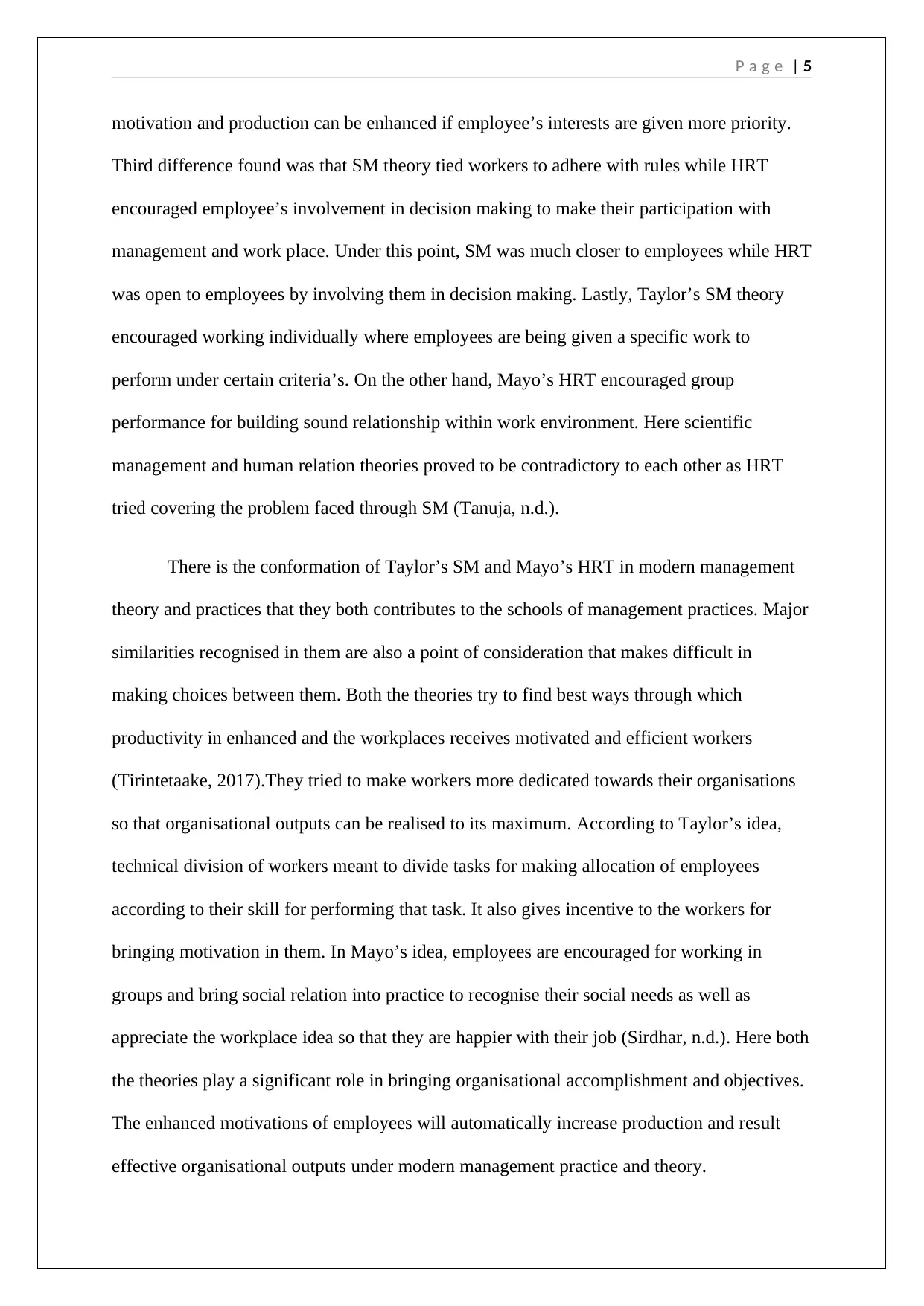
P a g e | 5
motivation and production can be enhanced if employee’s interests are given more priority.
Third difference found was that SM theory tied workers to adhere with rules while HRT
encouraged employee’s involvement in decision making to make their participation with
management and work place. Under this point, SM was much closer to employees while HRT
was open to employees by involving them in decision making. Lastly, Taylor’s SM theory
encouraged working individually where employees are being given a specific work to
perform under certain criteria’s. On the other hand, Mayo’s HRT encouraged group
performance for building sound relationship within work environment. Here scientific
management and human relation theories proved to be contradictory to each other as HRT
tried covering the problem faced through SM (Tanuja, n.d.).
There is the conformation of Taylor’s SM and Mayo’s HRT in modern management
theory and practices that they both contributes to the schools of management practices. Major
similarities recognised in them are also a point of consideration that makes difficult in
making choices between them. Both the theories try to find best ways through which
productivity in enhanced and the workplaces receives motivated and efficient workers
(Tirintetaake, 2017).They tried to make workers more dedicated towards their organisations
so that organisational outputs can be realised to its maximum. According to Taylor’s idea,
technical division of workers meant to divide tasks for making allocation of employees
according to their skill for performing that task. It also gives incentive to the workers for
bringing motivation in them. In Mayo’s idea, employees are encouraged for working in
groups and bring social relation into practice to recognise their social needs as well as
appreciate the workplace idea so that they are happier with their job (Sirdhar, n.d.). Here both
the theories play a significant role in bringing organisational accomplishment and objectives.
The enhanced motivations of employees will automatically increase production and result
effective organisational outputs under modern management practice and theory.
motivation and production can be enhanced if employee’s interests are given more priority.
Third difference found was that SM theory tied workers to adhere with rules while HRT
encouraged employee’s involvement in decision making to make their participation with
management and work place. Under this point, SM was much closer to employees while HRT
was open to employees by involving them in decision making. Lastly, Taylor’s SM theory
encouraged working individually where employees are being given a specific work to
perform under certain criteria’s. On the other hand, Mayo’s HRT encouraged group
performance for building sound relationship within work environment. Here scientific
management and human relation theories proved to be contradictory to each other as HRT
tried covering the problem faced through SM (Tanuja, n.d.).
There is the conformation of Taylor’s SM and Mayo’s HRT in modern management
theory and practices that they both contributes to the schools of management practices. Major
similarities recognised in them are also a point of consideration that makes difficult in
making choices between them. Both the theories try to find best ways through which
productivity in enhanced and the workplaces receives motivated and efficient workers
(Tirintetaake, 2017).They tried to make workers more dedicated towards their organisations
so that organisational outputs can be realised to its maximum. According to Taylor’s idea,
technical division of workers meant to divide tasks for making allocation of employees
according to their skill for performing that task. It also gives incentive to the workers for
bringing motivation in them. In Mayo’s idea, employees are encouraged for working in
groups and bring social relation into practice to recognise their social needs as well as
appreciate the workplace idea so that they are happier with their job (Sirdhar, n.d.). Here both
the theories play a significant role in bringing organisational accomplishment and objectives.
The enhanced motivations of employees will automatically increase production and result
effective organisational outputs under modern management practice and theory.
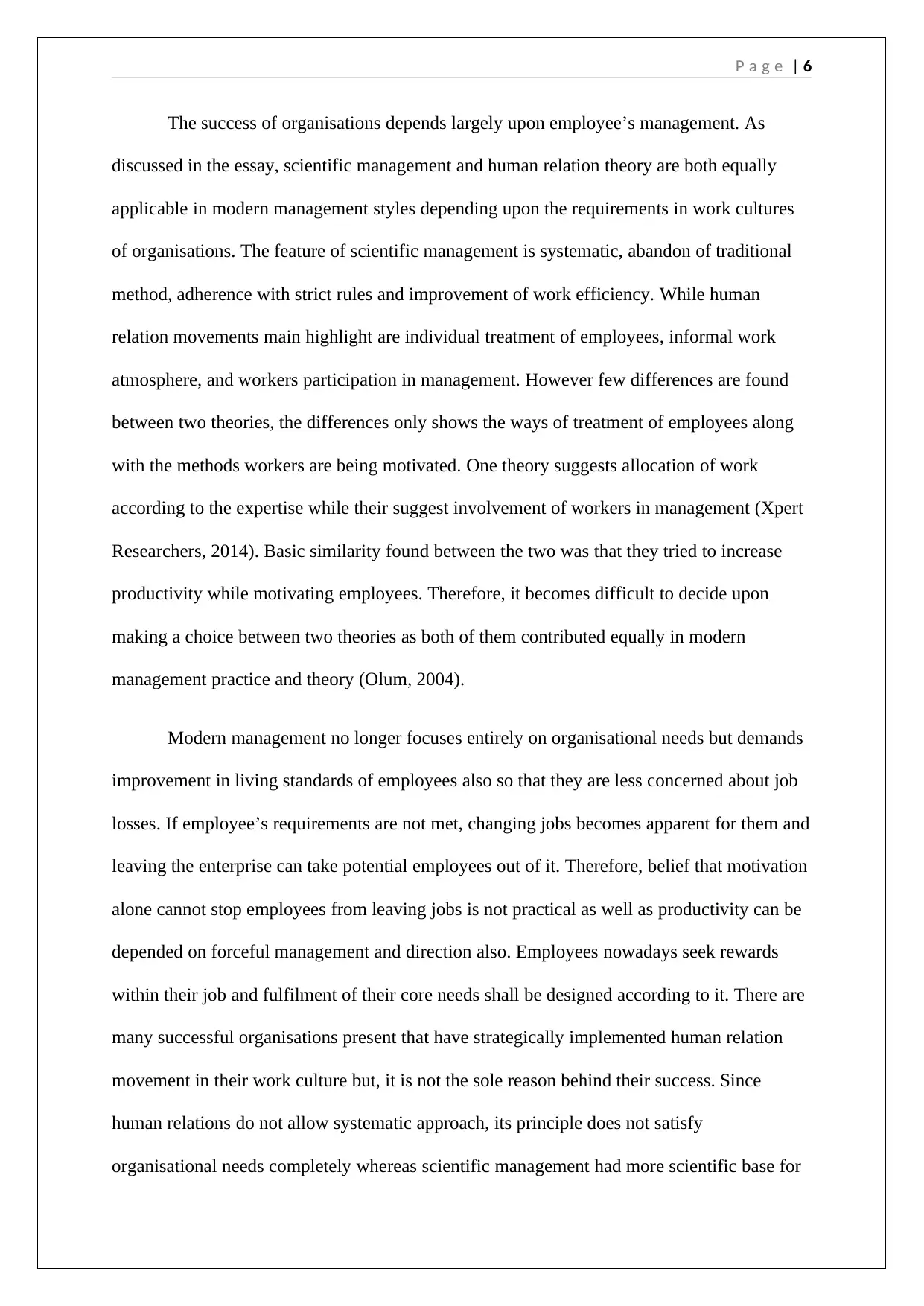
P a g e | 6
The success of organisations depends largely upon employee’s management. As
discussed in the essay, scientific management and human relation theory are both equally
applicable in modern management styles depending upon the requirements in work cultures
of organisations. The feature of scientific management is systematic, abandon of traditional
method, adherence with strict rules and improvement of work efficiency. While human
relation movements main highlight are individual treatment of employees, informal work
atmosphere, and workers participation in management. However few differences are found
between two theories, the differences only shows the ways of treatment of employees along
with the methods workers are being motivated. One theory suggests allocation of work
according to the expertise while their suggest involvement of workers in management (Xpert
Researchers, 2014). Basic similarity found between the two was that they tried to increase
productivity while motivating employees. Therefore, it becomes difficult to decide upon
making a choice between two theories as both of them contributed equally in modern
management practice and theory (Olum, 2004).
Modern management no longer focuses entirely on organisational needs but demands
improvement in living standards of employees also so that they are less concerned about job
losses. If employee’s requirements are not met, changing jobs becomes apparent for them and
leaving the enterprise can take potential employees out of it. Therefore, belief that motivation
alone cannot stop employees from leaving jobs is not practical as well as productivity can be
depended on forceful management and direction also. Employees nowadays seek rewards
within their job and fulfilment of their core needs shall be designed according to it. There are
many successful organisations present that have strategically implemented human relation
movement in their work culture but, it is not the sole reason behind their success. Since
human relations do not allow systematic approach, its principle does not satisfy
organisational needs completely whereas scientific management had more scientific base for
The success of organisations depends largely upon employee’s management. As
discussed in the essay, scientific management and human relation theory are both equally
applicable in modern management styles depending upon the requirements in work cultures
of organisations. The feature of scientific management is systematic, abandon of traditional
method, adherence with strict rules and improvement of work efficiency. While human
relation movements main highlight are individual treatment of employees, informal work
atmosphere, and workers participation in management. However few differences are found
between two theories, the differences only shows the ways of treatment of employees along
with the methods workers are being motivated. One theory suggests allocation of work
according to the expertise while their suggest involvement of workers in management (Xpert
Researchers, 2014). Basic similarity found between the two was that they tried to increase
productivity while motivating employees. Therefore, it becomes difficult to decide upon
making a choice between two theories as both of them contributed equally in modern
management practice and theory (Olum, 2004).
Modern management no longer focuses entirely on organisational needs but demands
improvement in living standards of employees also so that they are less concerned about job
losses. If employee’s requirements are not met, changing jobs becomes apparent for them and
leaving the enterprise can take potential employees out of it. Therefore, belief that motivation
alone cannot stop employees from leaving jobs is not practical as well as productivity can be
depended on forceful management and direction also. Employees nowadays seek rewards
within their job and fulfilment of their core needs shall be designed according to it. There are
many successful organisations present that have strategically implemented human relation
movement in their work culture but, it is not the sole reason behind their success. Since
human relations do not allow systematic approach, its principle does not satisfy
organisational needs completely whereas scientific management had more scientific base for
⊘ This is a preview!⊘
Do you want full access?
Subscribe today to unlock all pages.

Trusted by 1+ million students worldwide
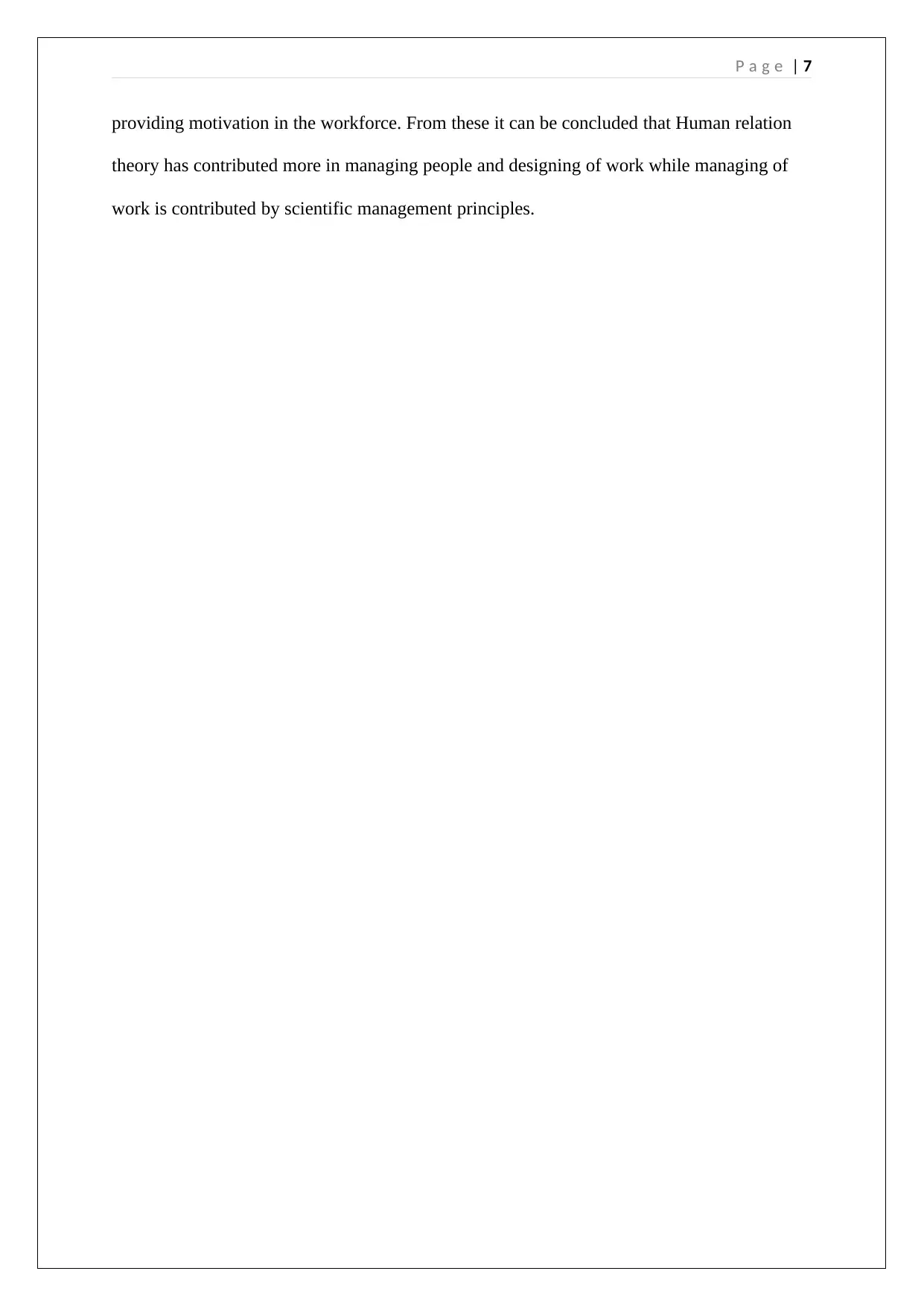
P a g e | 7
providing motivation in the workforce. From these it can be concluded that Human relation
theory has contributed more in managing people and designing of work while managing of
work is contributed by scientific management principles.
providing motivation in the workforce. From these it can be concluded that Human relation
theory has contributed more in managing people and designing of work while managing of
work is contributed by scientific management principles.
Paraphrase This Document
Need a fresh take? Get an instant paraphrase of this document with our AI Paraphraser
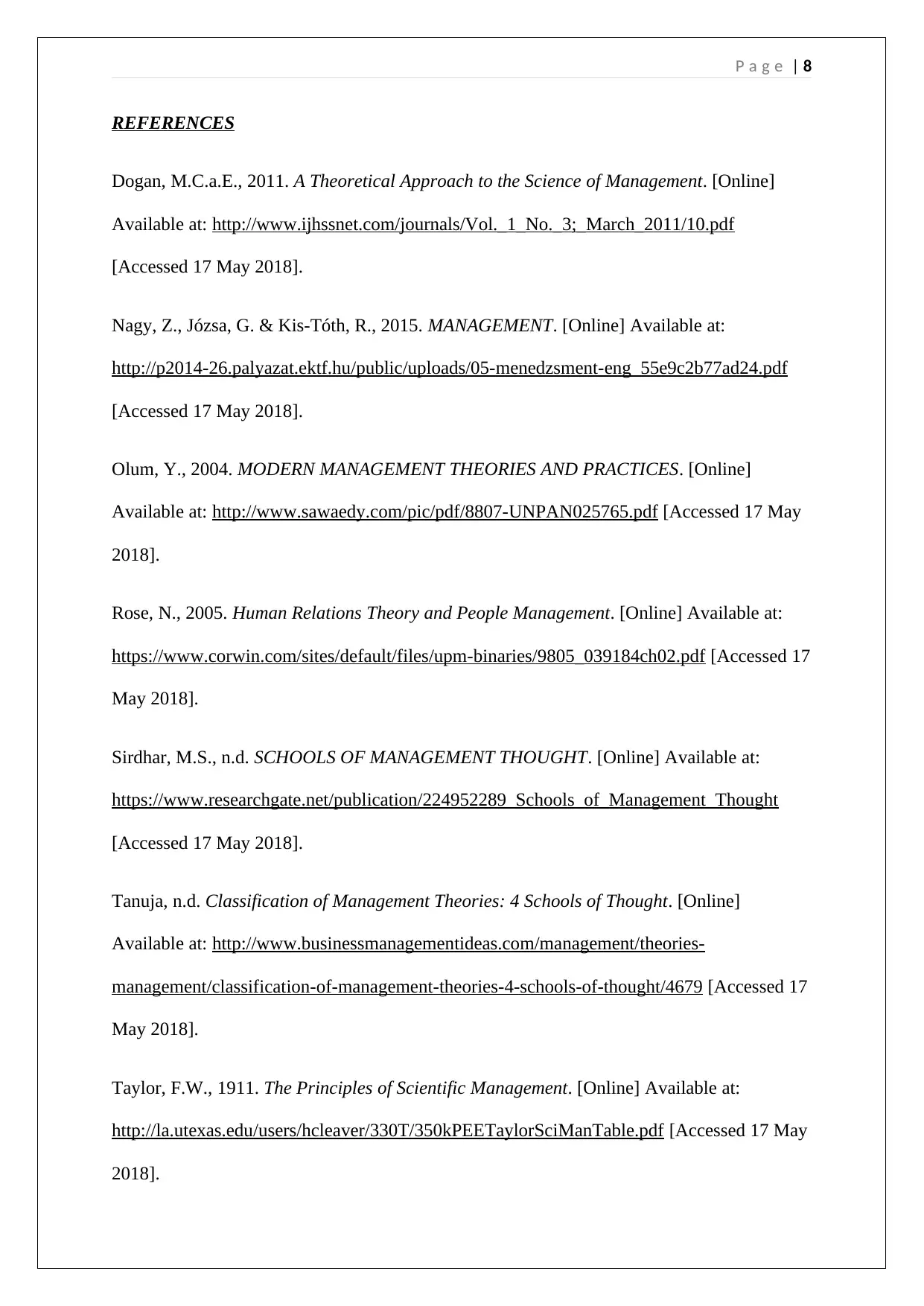
P a g e | 8
REFERENCES
Dogan, M.C.a.E., 2011. A Theoretical Approach to the Science of Management. [Online]
Available at: http://www.ijhssnet.com/journals/Vol._1_No._3;_March_2011/10.pdf
[Accessed 17 May 2018].
Nagy, Z., Józsa, G. & Kis-Tóth, R., 2015. MANAGEMENT. [Online] Available at:
http://p2014-26.palyazat.ektf.hu/public/uploads/05-menedzsment-eng_55e9c2b77ad24.pdf
[Accessed 17 May 2018].
Olum, Y., 2004. MODERN MANAGEMENT THEORIES AND PRACTICES. [Online]
Available at: http://www.sawaedy.com/pic/pdf/8807-UNPAN025765.pdf [Accessed 17 May
2018].
Rose, N., 2005. Human Relations Theory and People Management. [Online] Available at:
https://www.corwin.com/sites/default/files/upm-binaries/9805_039184ch02.pdf [Accessed 17
May 2018].
Sirdhar, M.S., n.d. SCHOOLS OF MANAGEMENT THOUGHT. [Online] Available at:
https://www.researchgate.net/publication/224952289_Schools_of_Management_Thought
[Accessed 17 May 2018].
Tanuja, n.d. Classification of Management Theories: 4 Schools of Thought. [Online]
Available at: http://www.businessmanagementideas.com/management/theories-
management/classification-of-management-theories-4-schools-of-thought/4679 [Accessed 17
May 2018].
Taylor, F.W., 1911. The Principles of Scientific Management. [Online] Available at:
http://la.utexas.edu/users/hcleaver/330T/350kPEETaylorSciManTable.pdf [Accessed 17 May
2018].
REFERENCES
Dogan, M.C.a.E., 2011. A Theoretical Approach to the Science of Management. [Online]
Available at: http://www.ijhssnet.com/journals/Vol._1_No._3;_March_2011/10.pdf
[Accessed 17 May 2018].
Nagy, Z., Józsa, G. & Kis-Tóth, R., 2015. MANAGEMENT. [Online] Available at:
http://p2014-26.palyazat.ektf.hu/public/uploads/05-menedzsment-eng_55e9c2b77ad24.pdf
[Accessed 17 May 2018].
Olum, Y., 2004. MODERN MANAGEMENT THEORIES AND PRACTICES. [Online]
Available at: http://www.sawaedy.com/pic/pdf/8807-UNPAN025765.pdf [Accessed 17 May
2018].
Rose, N., 2005. Human Relations Theory and People Management. [Online] Available at:
https://www.corwin.com/sites/default/files/upm-binaries/9805_039184ch02.pdf [Accessed 17
May 2018].
Sirdhar, M.S., n.d. SCHOOLS OF MANAGEMENT THOUGHT. [Online] Available at:
https://www.researchgate.net/publication/224952289_Schools_of_Management_Thought
[Accessed 17 May 2018].
Tanuja, n.d. Classification of Management Theories: 4 Schools of Thought. [Online]
Available at: http://www.businessmanagementideas.com/management/theories-
management/classification-of-management-theories-4-schools-of-thought/4679 [Accessed 17
May 2018].
Taylor, F.W., 1911. The Principles of Scientific Management. [Online] Available at:
http://la.utexas.edu/users/hcleaver/330T/350kPEETaylorSciManTable.pdf [Accessed 17 May
2018].
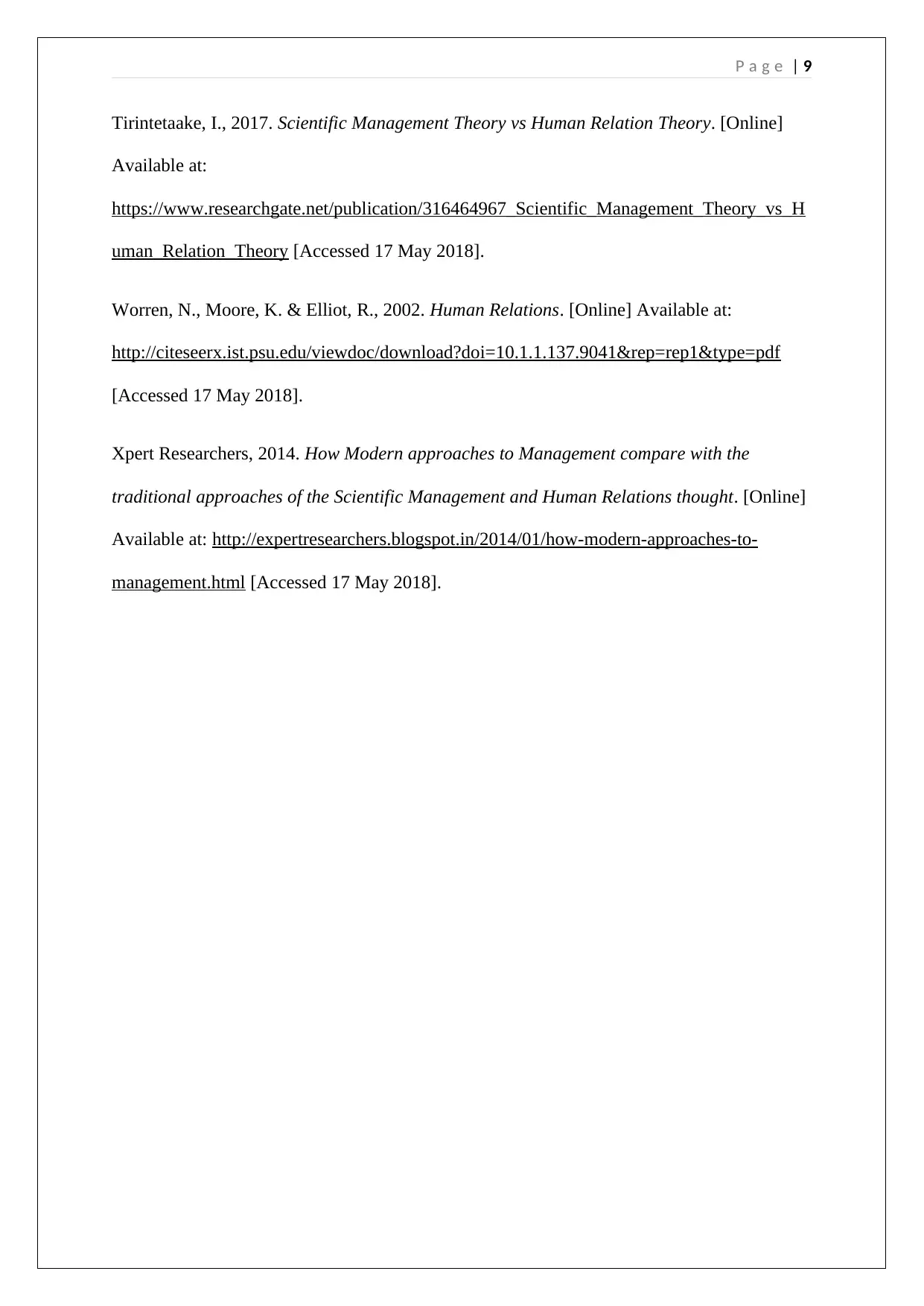
P a g e | 9
Tirintetaake, I., 2017. Scientific Management Theory vs Human Relation Theory. [Online]
Available at:
https://www.researchgate.net/publication/316464967_Scientific_Management_Theory_vs_H
uman_Relation_Theory [Accessed 17 May 2018].
Worren, N., Moore, K. & Elliot, R., 2002. Human Relations. [Online] Available at:
http://citeseerx.ist.psu.edu/viewdoc/download?doi=10.1.1.137.9041&rep=rep1&type=pdf
[Accessed 17 May 2018].
Xpert Researchers, 2014. How Modern approaches to Management compare with the
traditional approaches of the Scientific Management and Human Relations thought. [Online]
Available at: http://expertresearchers.blogspot.in/2014/01/how-modern-approaches-to-
management.html [Accessed 17 May 2018].
Tirintetaake, I., 2017. Scientific Management Theory vs Human Relation Theory. [Online]
Available at:
https://www.researchgate.net/publication/316464967_Scientific_Management_Theory_vs_H
uman_Relation_Theory [Accessed 17 May 2018].
Worren, N., Moore, K. & Elliot, R., 2002. Human Relations. [Online] Available at:
http://citeseerx.ist.psu.edu/viewdoc/download?doi=10.1.1.137.9041&rep=rep1&type=pdf
[Accessed 17 May 2018].
Xpert Researchers, 2014. How Modern approaches to Management compare with the
traditional approaches of the Scientific Management and Human Relations thought. [Online]
Available at: http://expertresearchers.blogspot.in/2014/01/how-modern-approaches-to-
management.html [Accessed 17 May 2018].
⊘ This is a preview!⊘
Do you want full access?
Subscribe today to unlock all pages.

Trusted by 1+ million students worldwide
1 out of 9
Related Documents
Your All-in-One AI-Powered Toolkit for Academic Success.
+13062052269
info@desklib.com
Available 24*7 on WhatsApp / Email
![[object Object]](/_next/static/media/star-bottom.7253800d.svg)
Unlock your academic potential
Copyright © 2020–2025 A2Z Services. All Rights Reserved. Developed and managed by ZUCOL.





